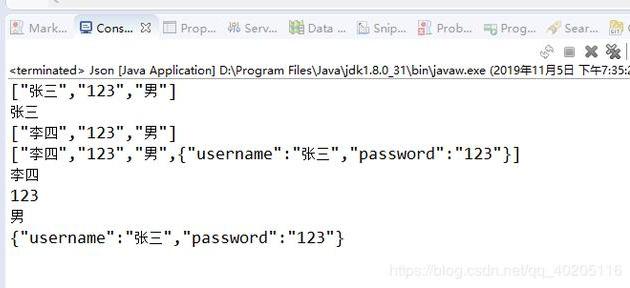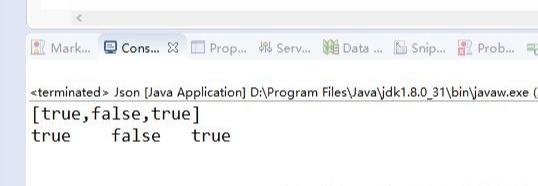文末会有读者福利
简介:
在程序开发过程中,在参数传递,函数返回值等方面,越来越多的使用JSON。JSON(JavaScript Object Notation)是一种轻量级的数据交换格式,同时也易于机器解析和生成、易于理解、阅读和撰写,而且Json采用完全独立于语言的文本格式,这使得 json 成为理想的数据交换语言。
JSON建构于两种结构:
“名称/值”对的集合(A Collection of name/value pairs),在不同的语言中,它被理解为对象(Object), 记录(record), 结构(struct), 字典(dictionary), 有趣列表(keyed list), 哈希表(hash table)或者关联数组(associative array)。
JSONObject依赖:
最后一行需要保留,有两个jdk版本的实现:json-lib-2.1-jdk13.jar和json-lib-2.1-jdk15.jar
<dependency>
<groupId>net. sf .json-lib</groupId>
<artifactId>json-lib</artifactId>
<version>2.4</version>
<classifier>jdk15</classifier>
</dependency>
使用net.sf.json需要导入的jar包
jar包下载:
JSONObject
创建JSONObject,添加属性
//创建JSONObject
JSONObject json = new JSONObject();
//添加属性
json.put("username", "张三");
json.put("password", "123");
//打印
System.out.println(json);
//增加属性
json.element("sex", "男");
json.put("age", 18);
System.out.println(json);
根据key返回输出
System.out.println(json.get("sex"));
判断输出对象的类型
boolean isArray = json.isArray();
boolean isEmpty = json.isEmpty();
boolean isNullObject = json.isNullObject();
System.out.println("是否数组:"+isArray+", 是否空:"+isEmpty+", 是否空为空对象:"+isNullObject);
把JSONArray添加到JSONObject中
/把JSONArray添加到JSONObject中
JSONArray jsonArray = new JSONArray();
jsonArray.add(0, "张三");
jsonArray.add(1, "123");
//开始添加
json.element("student", jsonArray);
System.out.println(json);
全部代码:
import net.sf.json.JSONArray;
import net.sf.json.JSONObject;
public class Json {
public static void main(String[] args) {
//创建JSONObject
JSONObject json = new JSONObject();
//添加属性
json.put("username", "张三");
json.put("password", "123");
//打印
System.out.println(json);
//增加属性
json.element("sex", "男");
json.put("age", 18);
System.out.println(json);
//根据key返回
System.out.println(json.get("sex"));
//判断输出对象的类型
boolean isArray = json.isArray();
boolean isEmpty = json.isEmpty();
boolean isNullObject = json.isNullObject();
System.out.println("是否数组:"+isArray+", 是否空:"+isEmpty+", 是否空为空对象:"+isNullObject);
System.out.println("=====");
//把JSONArray添加到JSONObject中
JSONArray jsonArray = new JSONArray();
jsonArray.add(0, "张三");
jsonArray.add(1, "123");
//开始添加
json.element("student", jsonArray);
System.out.println(json);
}
}
运行结果:

JSONArray
创建JSONArray,添加属性值
//创建JSONArray
JSONArray jsonArray = new JSONArray();
//添加
jsonArray.add(0, "张三");
jsonArray.add(1, "123");
jsonArray.element("男");
System.
根据下标返回输出
System.out.println(jsonArray.get(0));
根据下标设置新值,修改
jsonArray.set(0, "李四");
System.out.println(jsonArray);
把JSONObject放入到JSONArray中
//把JSONObject放入到JSONArray中
JSONObject jsonObject = new JSONObject();
jsonObject.put("username", "张三");
jsonObject.put("password", "123");
jsonArray.add(jsonObject);
System.
全部代码:
import net.sf.json.JSONArray;
import net.sf.json.JSONObject;
public class Json {
public static void main(String[] args) {
//创建JSONArray
JSONArray jsonArray = new JSONArray();
//添加
jsonArray.add(0, "张三");
jsonArray.add(1, "123");
jsonArray.element("男");
System.out.println(jsonArray);
//根据下标返回输出
System.out.println(jsonArray.get(0));
//根据下标设置新值,修改
jsonArray.set(0, "李四");
System.out.println(jsonArray);
//把JSONObject放入到JSONArray中
JSONObject jsonObject = new JSONObject();
jsonObject.put("username", "张三");
jsonObject.put("password", "123");
jsonArray.add(jsonObject);
System.out.println(jsonArray);
//循环输出
for(int i = 0; i < jsonArray.size(); i++) {
System.out.println(jsonArray.get(i));
}
}
}
运行结果

JavaBean 与json 字符串 互转
student类:
public class Student {
private String username;
private String password;
public String getUsername() {
return username;
}
public void setUsername(String username) {
this.username = username;
}
public String getPassword() {
return password;
}
public void setPassword(String password) {
this.password = password;
}
public Student(String username, String password) {
super();
this.username = username;
this.password = password;
}
public Student() {
super();
// TODO Auto-generated constructor stub
}
@Override
public String toString() {
return "Student [username=" + username + ", password=" + password + "]";
}
}
定义对象,JavaBean对象转json字符串
//定义对象
Student stu = new Student("张三", "123456");
//JavaBean对象转json字符串
JSONObject jsonObject = JSONObject.fromObject(stu);
System.out.println(jsonObject);
json字符串转为javaBean
//json字符串转为javaBean
//定义json字符串
String jsondata = "{"username":"李四", "password":"123"}";
//转为json对象
JSONObject json = JSONObject.fromObject(jsondata);
//转为JavaBean对象
Student stu2 = (Student)JSONObject.toBean(json, Student.class);
System.out.println(stu2.toString());
全部代码:
import net.sf.json.JSONObject;
public class Json {
public static void main(String[] args) {
//定义对象
Student stu = new Student("张三", "123456");
//JavaBean对象转json字符串
JSONObject jsonObject = JSONObject.fromObject(stu);
System.out.println(jsonObject);
//json字符串转为javaBean
//定义json字符串
String jsondata = "{"username":"李四", "password":"123"}";
//转为json对象
JSONObject json = JSONObject.fromObject(jsondata);
//转为JavaBean对象
Student stu2 = (Student)JSONObject.toBean(json, Student.class);
System.out.println(stu2.toString());
}
}
输出结果:

List与json字符串互转
先定义list集合,list转json字符串
//定义list集合
List list = new ArrayList();
list.add(new Student("张三", "123"));
list.add(new Student("李四", "456"));
//list转json字符串
JSONArray jsonArray = JSONArray.fromObject(list);
System.out.println(jsonArray);
json字符串转list
//json字符串转list
List list2 = new ArrayList();
String jsondata = "[{"password":"123","username":"张三"},{"password":"456","username":"李四"}]";
JSONArray jsonArray1 = JSONArray.fromObject(jsondata);
for(int i = 0; i < jsonArray1.size(); i++) {
JSONObject jsonObject2 = jsonArray1.getJSONObject(i);
Student stu2 = (Student)JSONObject.toBean(jsonObject2, Student.class);
list2.add(stu2);
}
System.out.println(list2);
全部代码
import java.util.ArrayList;
import java.util.List;
import net.sf.json.JSONArray;
import net.sf.json.JSONObject;
public class Json {
public static void main(String[] args) {
//定义list集合
List list = new ArrayList();
list.add(new Student("张三", "123"));
list.add(new Student("李四", "456"));
//list转json字符串
JSONArray jsonArray = JSONArray.fromObject(list);
System.out.println(jsonArray);
//json字符串转list
List list2 = new ArrayList();
String jsondata = "[{"password":"123","username":"张三"},{"password":"456","username":"李四"}]";
JSONArray jsonArray1 = JSONArray.fromObject(jsondata);
for(int i = 0; i < jsonArray1.size(); i++) {
JSONObject jsonObject2 = jsonArray1.getJSONObject(i);
Student stu2 = (Student)JSONObject.toBean(jsonObject2, Student.class);
list2.add(stu2);
}
System.out.println(list2);
}
}
运行结果

Map与json字符串互转
定义map集合,Map转json字符串
//定义map集合
Map map = new HashMap();
map.put("1", new Student("张三", "123"));
map.put("2", new Student("李四", "456"));
//Map转json字符串
JSONObject jsonMap = JSONObject.fromObject(map);
System.out.println(jsonMap);
定义字符串map集合,map集合字符串转为map
//定义字符串map集合
String jsondata = "{"1":{"password":"123","username":"张三"},"2":{"password":"456","username":"李四"}}";
//map集合字符串转为map
Map map2 = (Map)JSONObject.fromObject(jsondata);
Set set = map2.keySet();
//定义迭代器,迭代输出
Iterator ite = set.iterator();
while(ite.hasNext()) {
//取出一个字符串对象
String key = (String)ite.next();
//转为json格式
JSONObject jsonObject = JSONObject.fromObject(map2.get(key));
//转为对象
Student stu = (Student)JSONObject.toBean(jsonObject, Student.class);
System.out.println(key+" "+stu);
}
全部代码
import java.util.HashMap;
import java.util.Iterator;
import java.util.Map;
import java.util.Set;
import net.sf.json.JSONObject;
public class Json {
public static void main(String[] args) {
//定义map集合
Map map = new HashMap();
map.put("1", new Student("张三", "123"));
map.put("2", new Student("李四", "456"));
//Map转json字符串
JSONObject jsonMap = JSONObject.fromObject(map);
System.out.println(jsonMap);
//定义字符串map集合
String jsondata = "{"1":{"password":"123","username":"张三"},"2":{"password":"456","username":"李四"}}";
//map集合字符串转为map
Map map2 = (Map)JSONObject.fromObject(jsondata);
Set set = map2.keySet();
//定义迭代器,迭代输出
Iterator ite = set.iterator();
while(ite.hasNext()) {
//取出一个字符串对象
String key = (String)ite.next();
//转为json格式
JSONObject jsonObject = JSONObject.fromObject(map2.get(key));
//转为对象
Student stu = (Student)JSONObject.toBean(jsonObject, Student.class);
System.out.println(key+" "+stu);
}
}
}
运行结果:

SONArray与List互转
定义list集合,List转型JSONArray
//定义list集合
List<Student> list = new ArrayList<Student>();
list.add(new Student("张三", "123"));
list.add(new Student("李四", "456"));
//List转型JSONArray
JSONArray jsonArray = JSONArray.fromObject(list);
System.out.println(jsonArray.toString());
JSONArray转型List,JSONArray是用的上面的那个jsonArray变量
//JSONArray转型List
List<Student> list2 = JSONArray.toList(jsonArray, new Student(), new JsonConfig());
Iterator<Student> ite = list2.iterator();
while(ite.hasNext()) {
Student stu = ite.next();
System.out.println(stu);
}
全部代码
import java.util.ArrayList;
import java.util.Iterator;
import java.util.List;
import net.sf.json.JSONArray;
import net.sf.json.JsonConfig;
public class Json {
public static void main(String[] args) {
//定义list集合
List<Student> list = new ArrayList<Student>();
list.add(new Student("张三", "123"));
list.add(new Student("李四", "456"));
//List转型JSONArray
JSONArray jsonArray = JSONArray.fromObject(list);
System.out.println(jsonArray.toString());
//JSONArray转型List
List<Student> list2 = JSONArray.toList(jsonArray, new Student(), new JsonConfig());
Iterator<Student> ite = list2.iterator();
while(ite.hasNext()) {
Student stu = ite.next();
System.out.println(stu);
}
}
}
运行结果

JSONArray与数组互转
定义数组,数组转JSONArray
//定义数组
boolean[] boolArray = {true, false, true};
//java数组转JSONArray
JSONArray jsonArray = JSONArray.fromObject(boolArray);
System.out.println(jsonArray.toString());
JSONArray转java数组
//JSONArray转java数组
Object obj[] = jsonArray.toArray();
for(Object o : obj) {
System.out.print(o+"t");
}
全部代码
import net.sf.json.JSONArray;
public class Json {
public static void main(String[] args) {
//定义数组
boolean[] boolArray = {true, false, true};
//java数组转JSONArray
JSONArray jsonArray = JSONArray.fromObject(boolArray);
System.out.println(jsonArray.toString());
//JSONArray转java数组
Object obj[] = jsonArray.toArray();
for(Object o : obj) {
System.out.print(o+"t");
}
}
}
运行结果:

感谢阅读 喜欢的朋友和爱学习的小伙伴可关注下笔者 会定期发布优质文章的哦!
以下是笔者整理的大量的java面试和结构资料,有需要的朋友需‘关注’+‘私信’【资料】即可获得



本文链接:


